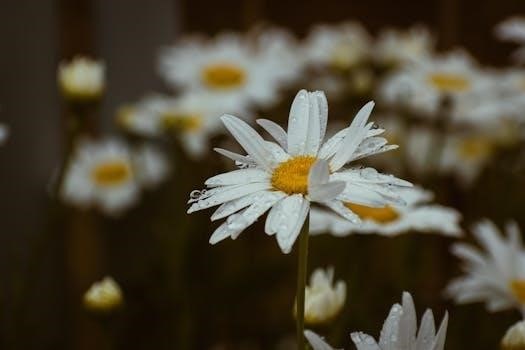yellow after the rain pdf
Yellowing leaves, also known as chlorosis, signal an issue with a plant’s chlorophyll production․ This can stem from various factors, requiring some investigation to identify the root cause․ It is crucial to find out what is wrong with your plant in order to save it․
Understanding Chlorosis⁚ Why Leaves Turn Yellow
Chlorosis, the yellowing of leaves, happens because chlorophyll, the pigment that makes plants green, is being hindered․ This hindrance prevents the plant from photosynthesizing effectively․ This is a sign that something is impacting the plant’s ability to produce or maintain chlorophyll․ The reason for this color change can be varied, ranging from environmental factors to nutrient deficiencies․ Chlorosis indicates that the plant is not functioning optimally, and its leaves are losing the green pigment essential for converting light energy into food․ It’s crucial to identify the cause of chlorosis to address the underlying problem and restore the plant’s health․ Addressing these problems early is key to ensuring the overall plant health․

Common Causes of Yellowing Leaves
Several issues can trigger yellowing leaves, including moisture problems, lighting, nutrient deficiencies, pests, and infections․ Identifying the specific cause is essential for effective treatment․
Moisture Stress⁚ Overwatering and Underwatering
Moisture stress is a primary cause of yellowing leaves, manifesting through both overwatering and underwatering․ Overwatering can suffocate roots, leading to root rot and hindering nutrient absorption, resulting in yellowing․ Conversely, underwatering causes dehydration and nutrient deficiencies, also causing leaves to yellow, often with drooping․ The key is to find a balance, allowing the soil to dry out slightly between waterings, while preventing it from becoming either bone dry or waterlogged․ Overwatering is common in decorative pots without drainage․ Proper watering habits are crucial for plant health․
Lighting Issues⁚ Too Much or Too Little Light
Improper lighting is another common culprit for yellowing leaves․ Too much direct sunlight can scorch the leaves, leading to yellowing and eventually browning․ Conversely, insufficient light hinders photosynthesis, resulting in pale, weak growth and yellowing․ Plants have specific light requirements; some thrive in full sun, while others prefer shade․ Understanding a plant’s needs is crucial to provide adequate lighting․ It’s important to ensure that your plants are receiving the appropriate amount of light to maintain their health and prevent the leaves from turning yellow․
Nutrient Deficiencies⁚ Nitrogen, Phosphorus, Iron
Nutrient deficiencies are a frequent cause of yellowing leaves․ A lack of nitrogen can lead to overall yellowing, as it is essential for chlorophyll production․ Phosphorus deficiency may cause the tips of leaves to turn yellow and brown․ Iron deficiency, also known as iron chlorosis, can result in yellowing between the leaf veins․ Ensure your plant’s soil has sufficient nutrients through regular fertilization․ Correcting these deficiencies promptly is crucial for plant health․ These nutrients are necessary for plant growth, and a lack of them will cause discoloration․
Pest Infestations⁚ Aphids, Spider Mites, Mealybugs
Pest infestations can be a significant cause of yellowing leaves․ Aphids, spider mites, and mealybugs feed on plant sap, draining nutrients and causing leaves to yellow․ These pests can also introduce diseases, further stressing the plant․ Regular inspections are essential to catch infestations early․ Look for signs like webbing or discolored spots on the leaves․ Treat infestations promptly with organic insecticides or natural remedies like neem oil to prevent further damage and promote plant health․ These pests will drain the plant of its lifeblood and eventually it will show in the leaves by turning them yellow․
Fungal and Bacterial Infections
Fungal and bacterial infections are another culprit behind yellowing leaves․ These pathogens can disrupt the plant’s ability to absorb nutrients, causing chlorosis․ Infections often manifest as yellow spots or overall yellowing․ Root rot, caused by excessive moisture, is a common issue that can lead to leaves yellowing and dropping off․ It’s important to identify the type of infection to apply the appropriate treatment․ Maintaining good air circulation and avoiding overwatering can help prevent these infections․ Early detection and treatment are crucial to prevent the spread of disease and save the plant․

Identifying the Cause
Pinpointing the cause of yellowing leaves requires careful observation․ Look for patterns⁚ are all leaves affected, or just older ones? This distinction helps narrow down the possibilities․
Observing the Pattern⁚ Uniform vs․ Older Leaves First
The distribution of yellowing on a plant can offer vital clues about the underlying problem․ If all the leaves, both young and old, are turning yellow uniformly, it often indicates a widespread issue․ This could be related to overwatering, underwatering, nutrient deficiencies, or insufficient light exposure․ On the other hand, if the yellowing is primarily affecting the older, lower leaves first, this is often a natural part of the plant’s growth cycle․ As plants grow, they sometimes redirect nutrients to new growth, causing older leaves to lose chlorophyll․ However, if yellowing begins on lower leaves and moves upward, it might be a sign of a nutrient deficiency or other problem․

Treatment and Prevention
Addressing yellow leaves involves adjusting care routines․ This may include changing watering habits, correcting lighting conditions, fertilizing, or controlling pests and diseases, and pruning affected leaves to improve plant health․
Adjusting Watering Habits
Moisture stress is a common cause of yellowing leaves․ Both overwatering and underwatering can lead to this problem․ Overwatering can suffocate roots, leading to root rot and hindering nutrient absorption․ Conversely, underwatering causes dehydration and nutrient deficiencies․ The key is to find a balance․ Allow the soil to dry slightly between waterings but avoid letting it become bone dry or waterlogged․ Ensure proper drainage to prevent water from accumulating around the roots․ Pay attention to the specific needs of your plants, as different species have varying water requirements․ Regular observation is crucial to detecting early signs of moisture stress․
Correcting Lighting Conditions
Improper lighting can also cause leaves to turn yellow․ Too much direct sunlight can scorch leaves, leading to yellowing and eventual browning․ Conversely, insufficient light can result in pale, weak growth as the plant struggles to photosynthesize; It’s important to understand the light requirements of your specific plant․ Some plants thrive in full sun, while others prefer shade․ Observe your plants for signs of light stress, such as pale or scorched leaves․ Adjust their location accordingly to ensure they receive the appropriate amount of light․ Providing the right amount of light is important for the plants to be healthy․
Fertilizing and Nutrient Management
Nutrient deficiencies are a common cause of yellowing leaves․ A lack of essential nutrients like nitrogen, phosphorus, iron, or magnesium can hinder chlorophyll production․ Assess your plant’s soil to ensure it has sufficient nutrients․ Use a balanced fertilizer to replenish these lost nutrients․ It’s also important to note that excessive fertilization can also harm plants․ Follow the recommended dosage on the fertilizer label․ A lack of phosphorus can cause the tips of leaves to turn yellow and brown․ You can add phosphorus-rich fertilizer or use foliar spray․ Regularly check the potting soil․
Pest and Disease Control
Pest infestations and fungal or bacterial infections can also cause leaves to turn yellow․ Pests like aphids, spider mites, and mealybugs suck plant sap, draining nutrients and causing yellowing․ Inspect your plants regularly for signs of pests such as webbing or discolored spots․ Treat infestations quickly using organic insecticides or natural remedies such as neem oil․ Fungal or bacterial infections can lead to yellow spots or overall yellowing of the leaves․ Remove affected leaves promptly to prevent further spread and address the specific infection with appropriate treatments․
Pruning Yellow Leaves
When you notice yellow leaves, it’s crucial to consider pruning as part of your plant care routine․ Use a sterile cutting tool to remove yellow leaves, avoiding pulling them off․ Allow the leaf to turn completely yellow before cutting since the plant continues to absorb leftover nutrients from it․ Cut the leaf only, leaving the stem․ This helps redirect the plant’s energy to healthier growth․ Removing yellow or damaged leaves can also prevent the spread of disease or pests to other parts of the plant․ Pruning is a useful tool in maintaining the health of your plant․

When Yellow Leaves Are Irreversible
Sometimes, yellowing leaves indicate severe damage that may be irreversible․ If the plant is too far gone, it may be impossible to restore its health, despite your best efforts․
Recognizing Signs of Severe Damage
When leaves turn yellow, it does not necessarily mean that the plant is dying․ However, there are some signs that signal severe damage and a possible irreversible state․ If the yellowing is widespread across the plant and not just on older leaves, it could be a sign of a major issue․ Additionally, if the leaves are dry, crispy, and easily fall off, this indicates significant damage․ If the yellow leaves are accompanied by wilting or drooping of the stems, then the damage may be severe․ Also, the presence of root rot or a foul odor coming from the soil suggests that the damage may be too far gone to be saved․